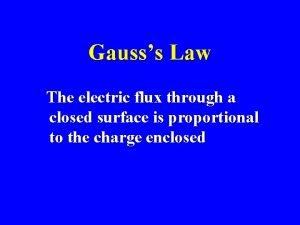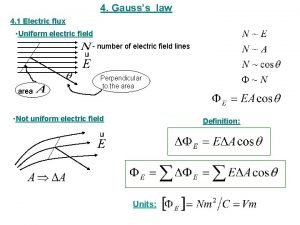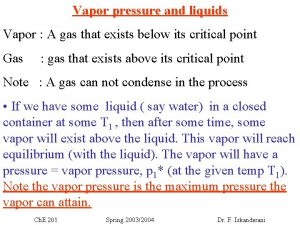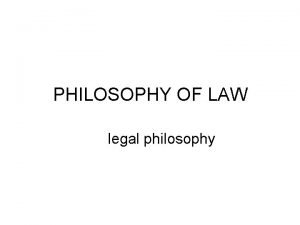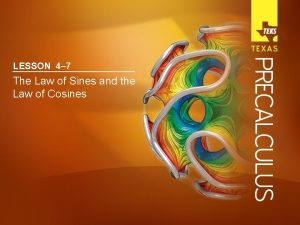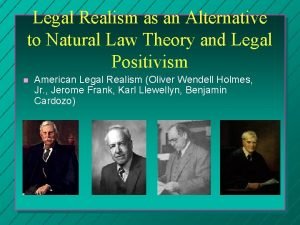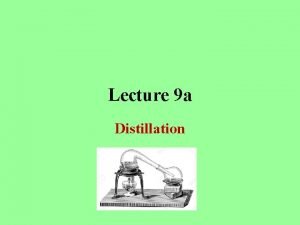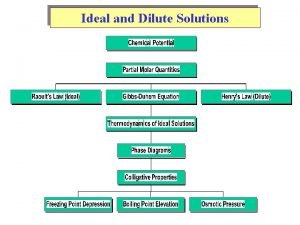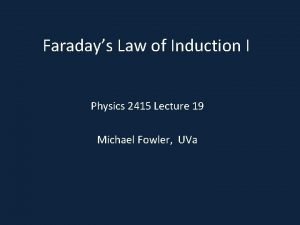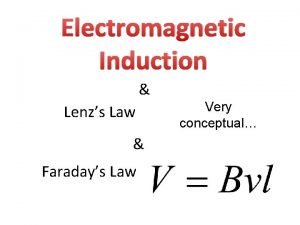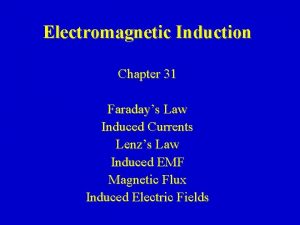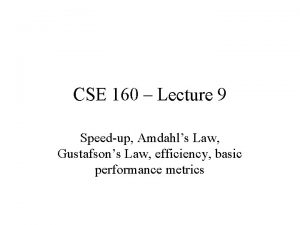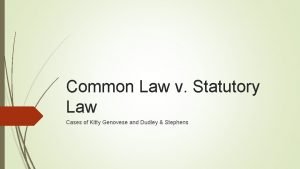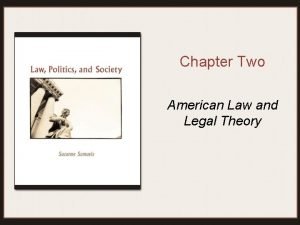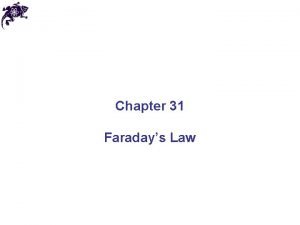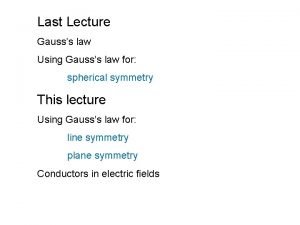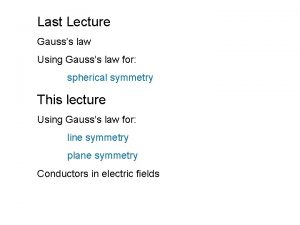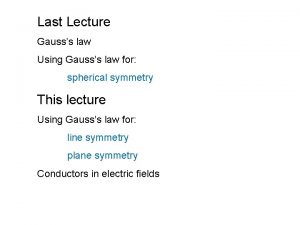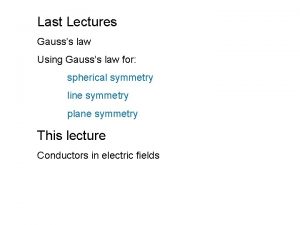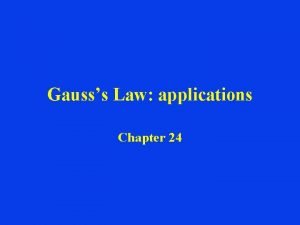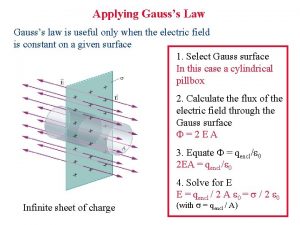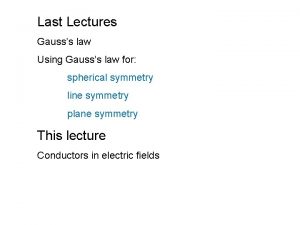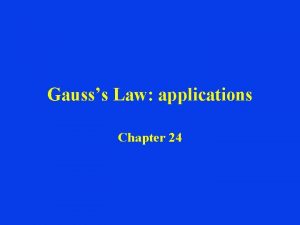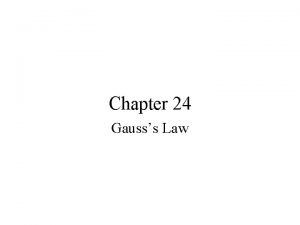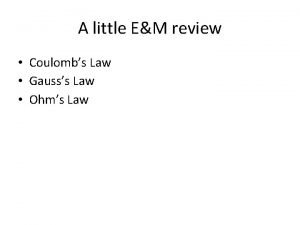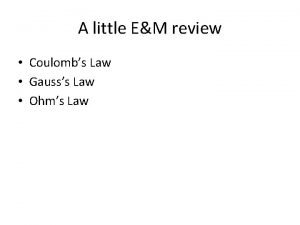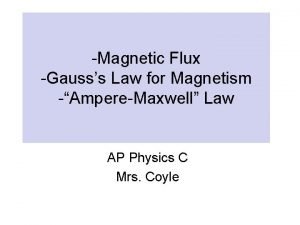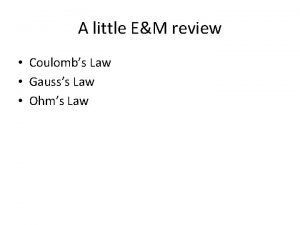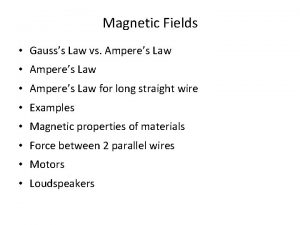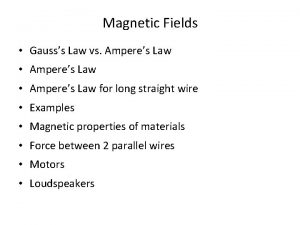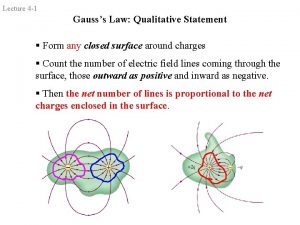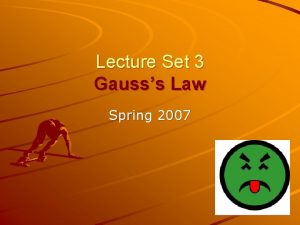Lecture 3 Gausss Law Ch 23 Physlet http
































- Slides: 32

Lecture 3 Gauss’s Law Ch. 23 • Physlet http: //webphysics. davidson. edu/physletprob/ch 9_problems/ ch 9_2_gauss/default. html • Topics –Electric Flux –Gauss’ Law –Coulombs Law from Gauss’ Law –Isolated conductor and Electric field outside conductor –Application of Gauss’ Law –Conductor in a uniform field • Demo –Faraday Ice pail: metal cup, charge ball, teflon rod, silk, electroscope, electrometer • Elmo 1 –Problems 29

Examples of Field Lines 2

Electric Flux Electric flux is the number of Electric field lines penetrating a surface or an area. Call it. 3

1. E A 2. A θ E 4

Gauss’s Law - Powerful relationship between charges and electric fields through closed surfaces • Gauss’s law makes it possible to find the electric field easily in highly symmetric situations. • If there is no charge inside, then the flux is 0 • Let look at an example 5

Derivation of Gauss’ Law from a point charge and using Coulombs law: Summary of steps • Start with an isolated point charge. • Choose a sphere around the charge. • Calculate • Show that 6

Start with a point charge. Note that the electric lines of flux are radial for a point charge Choose a spherical surface to simplify the calculation of the flux E 7

• Calculate the net flux through the closed surface. Net Flux = For a Point charge d. A Gauss’ Law 8 Valid even when charges are not at the center

Find the electric flux through a cylindrical surface in a uniform electric field E Uniform electric field Cylindrical surface choose because of symmetry No charge inside Flux should be 0 We want to calculate 9

Remember A A q A 10

a. What would be the flux if the cylinder were vertical ? b. c. Flux from a. + b. + c. = 0 Suppose it were any shape? 11 as expected

Gauss’ Law This result can be extended to any shape surface with any number of point charges inside and outside the surface as long as we evaluate the net flux through it. 12

Approximate Flux Exact Flux Circle means you integrate over a closed surface. 13

You should know these things 1 2 3 4 5 6 7 8 9 The electric field inside a conductor is 0. The total net charge inside a conductor is 0. It resides on the surface. Find electric field just outside the surface of a conductor. Find electric field around two parallel flat conducting planes. Find electric field of a large non-conducting sheet of charge σ. Find electric field of an infinitely long uniformly line of charge λ. Find E inside and outside of a long non-conducting solid cylinder of uniform charge density ρ. Find E for a thin cylindrical shell of surface charge density σ Find E inside and outside a solid non-conducting sphere of uniform charge density ρ. 14

1. Electric field inside a conductor is 0. Why? • Inside a conductor in electrostatic equilibrium the electric field is always zero. (averaged over many atomic volumes) • The electrons in a conductor move around so that they cancel out any electric field inside the conductor resulting from free charges anywhere including outside the conductor. This results in a net force of 0 on any particular charge inside the conductor. 15

2. The net charge inside a conductor is 0. • Any net electric charge resides on the surface of the conductor within a few angstroms (10 -10 m). • Draw a Gaussian surface just inside the conductor. We know everywhere on this surface E=0. • Hence, the net flux is zero. From Gauss’s Law the net charge inside is zero. • Show Faraday ice pail demo. 16

3. Find electric field just outside the surface of a conductor • The electric field just outside a conductor has magnitude and is directed perpendicular to the surface. • Draw a small pill box that extends into the conductor. Since there is no field inside, all the flux comes out through the top. 17

4. Find electric field around two parallel flat conducting planes. 18

6. Find the electric field for a very long wire of length L that is uniformly charged. 19

6. Find the electric field for a very long wire of length L that is uniformly charged. 20

9. Electric field inside and outside a nonconducting solid uniformly charged sphere • Often used as a model of the nucleus. • Electron scattering experiments have shown that the charge density is constant for some radius and then suddenly drops off at about For the nucleus, Charge density per unit volume R 21

Electric Field inside and outside a uniformly charged sphere Inside the sphere: To find the charge at a distance r<R Draw a gaussian surface of radius r By symmetry E is radial and parallel to normal at the surface. By Gauss’s Law: 22

Electric Field inside and outside a uniformly charged sphere Outside the sphere: Same as a point charge q 23

Electric field vs. radius for a nonconducting solid sphere filled with a uniform charge distribution 24

Problem 23 -4 A charge of - 5 u. C is placed inside a neutral conducting shell at R/2. What is the charge on the inner and outer surface of the shell? How is it distributed? What are the field lines inside and outside the shell? 25

Problem 23 -4 26

Chapter 23 Problem 29 Elmo A long straight wire has a fixed negative charge with a linear charge density of magnitude 3. 1 n. C/m. The wire is to be enclosed by a coaxial, thin walled, nonconducting cylindrical shell of radius 1. 8 cm. The shell is to have positive charge on its outside surface with a surface charge density that makes the net external electric field zero. Calculate the surface charge density. 27

Here is a essay question you should be able to answer based on our ideas so far 1) Suppose you put a neutral ideal conducting solid sphere in a region of space in which there is, initially, a uniform electric field. a) Describe (as specifically as possible) the electric field inside the conductor. b) Describe the distribution of charge in and on the conductor. c) Describe the electric field lines at the surface of the conductor. 28

External Electric field penetrates conductor E Free charges inside conductor move around onto the surface in such a way as to cancel out the field inside. E 29

E=0 inside conducting sphere E E 30

Orientation of electric field is perpendicular to surface E If the electric field were not perpendicular, then there would be a component of electric field along the surface causing charges to accelerate on the surface and it would not be in electrostatic equilibrium contrary to experience. 31

More questions to ask your self 2) Suppose you put some charge on an initially-neutral, solid, perfectly-conducting sphere (where the sphere is not in a preexisting electric field). – Describe the electric field inside the conductor, – Describe the electric field at the surface of the conductor, and outside the conductor as a result of the unbalanced charge. – Describe the distribution of the charge in and on the conductor. 3) Repeat questions 1 -3 for the case of a hollow perfectlyconducting spherical shell (with the interior being vacuum). 4) How would your answers to questions 1 -4 change if the conductor had some shape other than spherical? 32
 Gausss law
Gausss law Gausss law
Gausss law 01:640:244 lecture notes - lecture 15: plat, idah, farad
01:640:244 lecture notes - lecture 15: plat, idah, farad Newton's first law and second law and third law
Newton's first law and second law and third law Newton's first law of motion
Newton's first law of motion V=k/p
V=k/p Boyle's law charles law avogadro's law
Boyle's law charles law avogadro's law Http //mbs.meb.gov.tr/ http //www.alantercihleri.com
Http //mbs.meb.gov.tr/ http //www.alantercihleri.com Siat.ung.ac.id
Siat.ung.ac.id Http://types of law
Http://types of law Raoult's law and dalton's law
Raoult's law and dalton's law What is a civil law
What is a civil law Natural law vs positive law
Natural law vs positive law Natural law vs positive law
Natural law vs positive law Stoicism natural law
Stoicism natural law Law of segregation vs law of independent assortment
Law of segregation vs law of independent assortment 4-7 the law of sines and the law of cosines answers
4-7 the law of sines and the law of cosines answers Positive law vs natural law
Positive law vs natural law Difference between raoult's law and dalton's law
Difference between raoult's law and dalton's law Criminal law plaintiff
Criminal law plaintiff Raoult's law and dalton's law
Raoult's law and dalton's law Mendel's law of independent assortment and segregation
Mendel's law of independent assortment and segregation Paramagnetic
Paramagnetic Faraday's law vs lenz's law
Faraday's law vs lenz's law Faraday law of electromagnetic induction
Faraday law of electromagnetic induction Raoult's law and dalton's law
Raoult's law and dalton's law Gustafsons law
Gustafsons law What are statute laws
What are statute laws Difference between common law and statute law
Difference between common law and statute law Positive law vs natural law
Positive law vs natural law Faraday's law vs lenz law
Faraday's law vs lenz law Natural law vs positive law
Natural law vs positive law Private law vs public law
Private law vs public law
